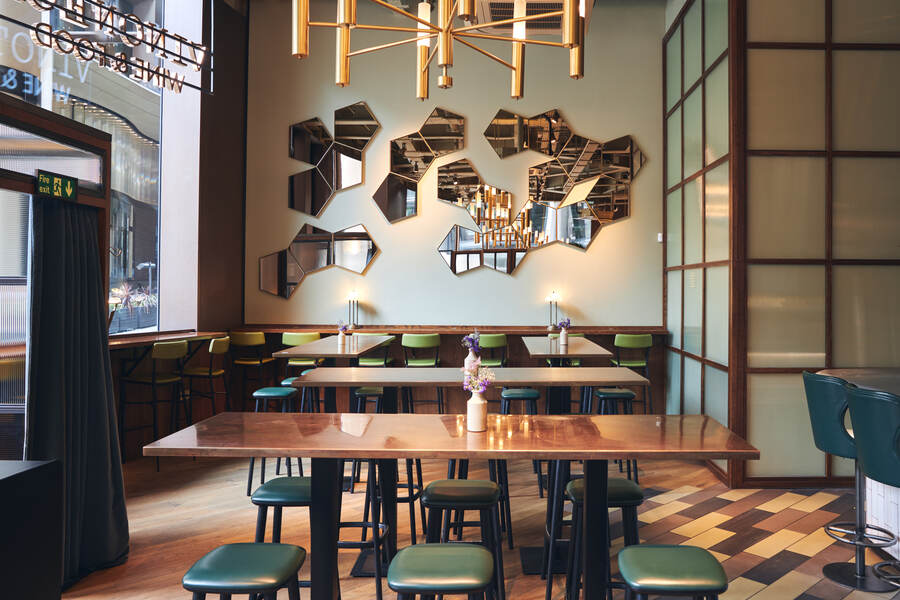
A restaurant’s interior design plays a crucial role in attracting customers, enhancing their dining experience, and ensuring they return. Today, restaurant owners are embracing innovative design elements to create spaces that are both aesthetically pleasing and functional. Here are some of the top restaurant interior design trends that can help create a memorable atmosphere.
1. Sustainable and Eco-Friendly Designs
With sustainability becoming a major focus across industries, restaurants are integrating eco-friendly elements into their interiors. This includes:
• Reclaimed Materials – Using recycled wood, metal, and other materials for furniture and decor.
• Energy-Efficient Lighting – LED lighting and natural light optimization to reduce energy consumption.
• Greenery and Indoor Plants – Living walls, potted plants, and herb gardens to enhance ambiance and air quality.
• Waste Management Systems – Composting and efficient recycling setups to minimize waste.
Also Read – How much do restaurant consultants charge in Delhi?
2. Open Kitchen Concepts
The open kitchen trend continues to gain popularity. Benefits of an open kitchen include:
• Engaging Customer Experience – Diners enjoy watching chefs prepare their meals.
• Enhanced Trust – Transparency in food preparation builds credibility and trust with guests.
• Aesthetic Appeal – Beautifully designed kitchens with modern equipment add to the restaurant’s visual appeal.
• Ventilation and Safety Considerations – Proper HVAC systems to maintain air quality and temperature control while ensuring kitchen safety.
3. Minimalist and Functional Designs
Minimalist design focuses on:
• Clean Lines and Neutral Colours – Simple yet sophisticated colour palettes.
• Multi-Functional Furniture – Space-saving, versatile seating options.
• Clutter-Free Layouts – Enhancing comfort and ease of movement for guests and staff.
• Optimized Storage Solutions – Hidden storage compartments for inventory management while maintaining a sleek aesthetic.
4. Unique and Thematic Decor
Popular thematic design ideas include:
• Vintage and Retro Vibes – Nostalgic decor elements from past decades.
• Industrial Aesthetic – Exposed brick, metal fixtures, and raw materials.
• Cultural Influence – Interiors inspired by global cultures for an authentic experience.
• Acoustic Considerations – Soundproofing elements to maintain an enjoyable noise level in themed environments.
Also Read – Fast Food Chains & Their Advantages: Convenience in Every Bite
5. Multi-Sensory Experiences
Interior design isn’t just about visuals; incorporating multiple sensory elements enhances the overall experience. Key aspects include:
• Ambient Music and Soundscapes – Custom playlists to match the restaurant’s theme.
• Aromatic Enhancements – Natural scents from fresh herbs, candles, or diffusers.
• Textured Elements – A mix of materials like wood, stone, and fabric for a tactile experience.
• Lighting Control Systems – Adjustable lighting to create different moods throughout the day.
6. Flexible Seating Arrangements
Diners appreciate the ability to choose seating that suits their mood and occasion. Restaurants are incorporating:
• Modular Seating – Easily movable tables and chairs to accommodate different group sizes.
• Private Booths and Communal Tables – Options for intimacy or social dining.
• Outdoor Seating Areas – Al fresco dining spaces for a refreshing experience.
• ADA Compliance – Ensuring seating arrangements meet accessibility requirements for all guests.
7. Instagrammable Spaces
Social media plays a huge role in restaurant marketing, and having an Instagram-worthy interior is a game-changer. Elements that encourage photo opportunities include:
• Statement Walls and Murals – Artistic backdrops that attract social media attention.
• Creative Lighting – Neon signs, chandeliers, or Edison bulbs for mood enhancement.
• Unique Tableware and Presentation – Visually appealing dishware that complements the decor.
• Ergonomic Layouts – Ensuring aesthetically pleasing elements do not compromise guest comfort and functionality.
8. Smart Technology Integration
Technology is seamlessly blending with interior design to improve customer convenience and operational efficiency. Key tech trends include:
• Self-Ordering Kiosks and QR Code Menus – Enhancing speed and efficiency.
• Automated Lighting and Climate Control – Creating the perfect ambiance at all times.
• Interactive Displays and Digital Art – Adding a modern and dynamic element to decor.
• POS System Integration – Streamlining operations with seamless order-taking and payment processing.
• AI-Based Customer Insights – Using smart data collection to optimize seating arrangements and personalize guest experiences.
A well-designed restaurant interior sets the stage for an unforgettable dining experience. By incorporating sustainability, functionality, thematic elements, and technology, restaurant owners can create a unique and inviting atmosphere that keeps customers coming back. Investing in the right design trends ensures that your restaurant not only stands out but also offers an exceptional experience that diners will love and share. Considering technical aspects such as ventilation, acoustics, storage, and smart integrations will further enhance the operational efficiency and long-term success of a restaurant.
